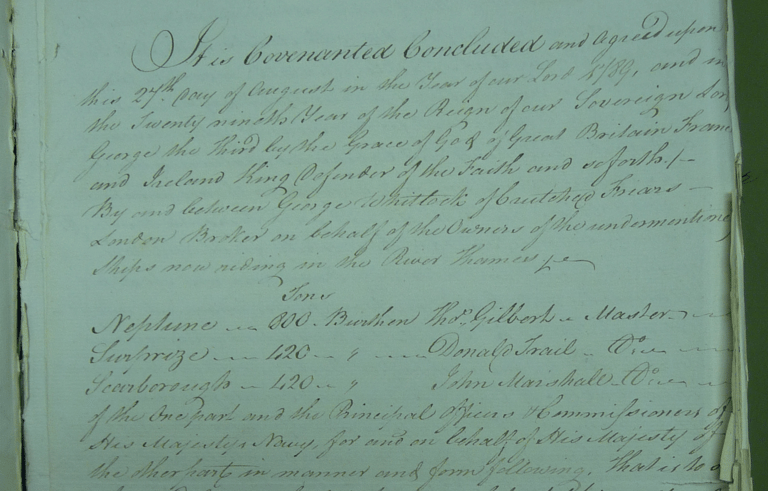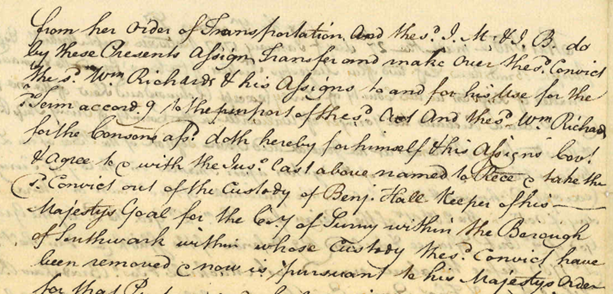Transportation Contracts
10/15/20243 min read


The contractual arrangements for the convict ships were a combination of two different systems:
A proprietary system which had been used for transporting convicts to North America prior to the War of Independence; and
Charter parties used by the Navy Board to hire merchant vessels for the transportation of troops, horses, ammunition and stores, most recently during the American War.
Introduction to the Contract for the Second Fleet (UK National Archives, CO201/6/273)
Extract of the Contract of Effectual Transportation for Mary Mitchell, convicted at Kingston-upon-Thames, Surrey, who was sent on the First Fleet (Surrey County Archives, KE2/4/6)


In August 1786, when the Botany Bay decision was made, the Navy Board initially thought that shipping convicts would be little different from transporting troops. There were some similarities, of course, but the Navy Board hired ships at a rate per ton per month through a contract known as a ‘charter party’, and it had to be adapted for passengers who were often brought on board suffering from typhus or scurvy, could not go on deck for fresh air whenever they liked, and would mutiny or escape if given the chance.
Convicts had been sent to North America prior to the American Revolution, but that system had been based on indentured servitude – this was a legal arrangement through which poor British and Irish emigrants could pay for their passage across the Atlantic by selling their labour to the captain of the ship for a number of years. He would recoup his costs by selling that contract to farmers or merchants on arrival in a North American port, with the emigrants being legally obliged to serve out the time of their indenture.
North American convicts were in servitude for the term of their sentence, usually seven years. Under this system, the key legal documents were indentures which transferred legal rights over the convicts' service to the contractor, and ‘bonds of effectual transportation’, by which the contractor guaranteed that the convicts would actually be removed out of the country. Since there was no European settlement when the First Fleet arrived in NSW, this system was adapted, with the contractor transferring the right to the convicts' service to the Governor.
So, in the period covered by this website, the Botany Bay system relied on both forms of contract:
The Transportation Contract: Contrary to the claims made by Charles Bateson in The Convict Ships (1959), and following him, Robert Hughes in The Fatal Shore (1986), there was a contract for the First Fleet. It was signed with Richards & Fernie, a small London shipbroking firm, which won the tender for the fleet (see the first and second part of my articles on the contractual arrangements for the First Fleet).
No copy of this contract has survived, although a sub-contract between William Richards and one of the ship owners, based on the charter party he signed with the Navy Board, does. This reflects the Navy Board’s standard transportation contracts - the agreement was based on a rate per ton per month for each ship, with separate clauses covering the supply of sea provisions for the convicts and marines, at a rate per man or woman per day.
The earliest surviving copy of a transportation contract is for the Second Fleet (image of the first part above) - with this contract, the Navy Board moved to a flat rate per head for the voyage, covering both the hire of the ships and the provisions. In effect, the contractors were paid for the number of convicts brought on board not the number landed, and the contractors were incentivised to make the voyage as fast as possible. This created perverse incentives which contributed to the high mortality rate.
Following the disaster of the Second Fleet, government began to experiment with contracts where the owners (and later the captains and surgeons) were paid in part based on the number of convicts landed alive. The range of contractual responsibilities also changed over time – from 1789 until 1794, the contractors were charged with supplying clothing for the convicts throughout the voyage; from the First Fleet until 1797, the contracts included the sea provisions, after which the Victualling Board assumed responsibility.
Indentures and Bonds of Effectual Transportation: A number of these survive, including several for the First Fleet. There is no evidence that the bonds were ever enforced, but the indentures were important because they gave the contractors, owners and masters clear legal authority to discipline the prisoners throughout the voyage. The following extract from a contract for a First Fleet convict refers to the said convict being assigned and transferred to the contractor, William Richards.
Contact us
Connect with us
Botany Baymen acknowledges the traditional custodians of country throughout Australia and respects their connection to land, water and community.
© Botany Baymen 2024. All rights reserved.
You may download, display, print and reproduce this content for your personal or non-commercial use but only in an unaltered form and with the copyright acknowledged.

